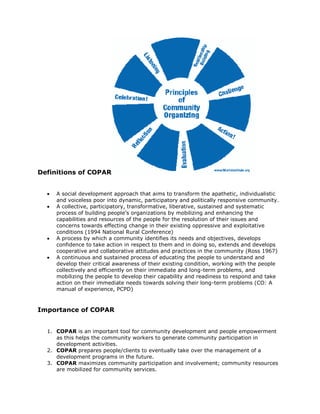
Definitions of copar
- 1. Definitions of COPAR A social development approach that aims to transform the apathetic, individualistic and voiceless poor into dynamic, participatory and politically responsive community. A collective, participatory, transformative, liberative, sustained and systematic process of building people’s organizations by mobilizing and enhancing the capabilities and resources of the people for the resolution of their issues and concerns towards effecting change in their existing oppressive and exploitative conditions (1994 National Rural Conference) A process by which a community identifies its needs and objectives, develops confidence to take action in respect to them and in doing so, extends and develops cooperative and collaborative attitudes and practices in the community (Ross 1967) A continuous and sustained process of educating the people to understand and develop their critical awareness of their existing condition, working with the people collectively and efficiently on their immediate and long-term problems, and mobilizing the people to develop their capability and readiness to respond and take action on their immediate needs towards solving their long-term problems (CO: A manual of experience, PCPD) Importance of COPAR 1. COPAR is an important tool for community development and people empowerment as this helps the community workers to generate community participation in development activities. 2. COPAR prepares people/clients to eventually take over the management of a development programs in the future. 3. COPAR maximizes community participation and involvement; community resources are mobilized for community services.
- 2. Principles of COPAR 1. People, especially the most oppressed, exploited and deprived sectors are open to change, have the capacity to change and are able to bring about change. 2. COPAR should be based on the interest of the poorest sectors of society 3. COPAR should lead to a self-reliant community and society. COPAR Process A progressive cycle of action-reflection action which begins with small, local and concrete issues identified by the people and the evaluation and the reflection of and on the action taken by them. Consciousness through experimental learning central to the COPAR process because it places emphasis on learning that emerges from concrete action and which enriches succeeding action. COPAR is participatory and mass-based because it is primarily directed towards and biased in favor of the poor, the powerless and oppressed. COPAR is group-centered and not leader-oriented. Leaders are identified, emerge and are tested through action rather than appointed or selected by some external force or entity. COPAR Phases of Process 1. Pre-entry Phase Is the initial phase of the organizing process where the community/organizer looks for communities to serve/help. It is considered the simplest phase in terms of actual outputs, activities and strategies and time spent for it Activities include: o Designing a plan for community development including all its activities and strategies for care development. o Designing criteria for the selection of site o Actually selecting the site for community care 2. Entry Phase Sometimes called the social preparation phase as to the activities done here includes the sensitization of the people on the critical events in their life, innovating them to
- 3. share their dreams and ideas on how to manage their concerns and eventually mobilizing them to take collective action on these. This phase signals the actual entry of the community worker/organizer into the community. She must be guided by the following guidelines however. o Recognizes the role of local authorities by paying them visits to inform them of their presence and activities. o The appearance, speech, behavior and lifestyle should be in keeping with those of the community residents without disregard of their being role models. o Avoid raising the consciousness of the community residents; adopt a low-key profile. 3. Organization Building Phase Entails the formation of more formal structures and the inclusion of more formal procedures of planning, implementation, and evaluating community-wide activities. It is at this phase where the organized leaders or groups are being given trainings (formal, informal, OJT) to develop their skills and in managing their own concerns/programs. 4. Sustenance and Strengthening Phase Occurs when the community organization has already been established and the community members are already actively participating in community-wide undertakings. At this point, the different communities setup in the organization building phase are already expected to be functioning by way of planning, implementing and evaluating their own programs with the overall guidance from the community-wide organization. Strategies used may include: o Education and training o Networking and linkaging o Conduct of mobilization on health and development concerns o Implementing of livelihood projects o Developing secondary leaders